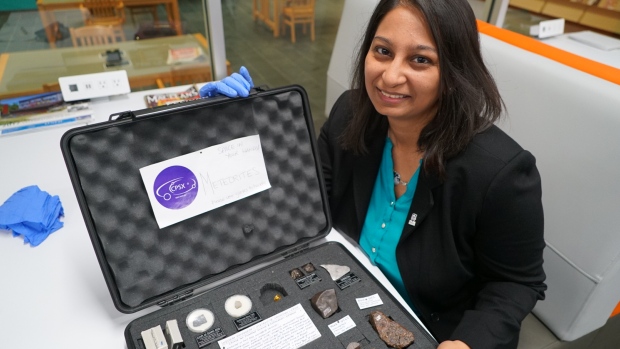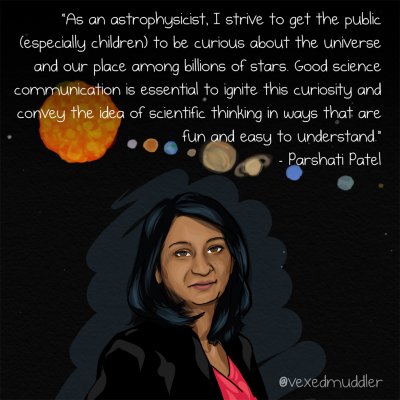
Media
When we Witnessed the Birth of a Nebula
Parshati Patel on History Channel. This is a story about how humans in 1054 AD witnessed the supernova that created the crab nebula.
Parshati Patel
Parshati is an astrophysicist, a planetary scientist and a science communicator. She has a PhD in Astronomy and Planetary Science and Exploration from the University of Western Ontario. Parshati investigates disks around young, massive stars. These stars are more massive than our Sun and are very young i.e. just starting to form a star. The disks of dust and gas around these stars are a hub for formation of planets. She will talk about how studying disks around massive stars help us understand about the planet formation process amongst variety of stars. Parshati currently works as an Public Education and Outreach Coordinator at Western University’s Centre for Planetary Science and Exploration.

Rocks from Space and Asteroid Day Celebrations
CBC Radio LondonRadio/Podcast
URL: http://www.cbc.ca/news/canada/london/western-university-asteroid-day-1.4185475
Asteroid Day is a global awareness campaign to teach people about asteroids and what everyone can do to protect our planet. Dr. Parshati Patel talks to Rebecca Zandbergen regarding rocks from space and Asteroid Day celebrations at Western University

Live Fast, Black Hole Young
CHRW Radio, September 2, 2015Radio/Podcast
URL: https://www.youtube.com/watch?v=7f41TXruinQ
Dr. Parshati Patel was invited to talk to Western University's radio station, CHRW's Gradcast, about her research work and outreach efforts at Western.
Bringing the universe to the community
Western News, February 27, 2014Print
URL: http://news.westernu.ca/2014/02/bringing-the-universe-to-the-community/
Western News talked to Dr. Patel about being engaged in the outreach efforts at the Cronyn Observatory.
Annual meteor shower will be even more active than usual this year
Woodstock Sentinel Review, August 9, 2016Print
Woodstock Sentinel Review talks to Dr. Parshati Patel about the upcoming Perseid meteor shower.
Women in Science & Exploration- Google Hangout
Exploring by the Seat of your Pants, February 10, 2017Online
URL: https://www.youtube.com/watch?v=95sNmyTjryY
Exploring by the Seat of Your Pants celebrated International Day of Women in Science and Exploration with a full day of Google Hangouts with leading women in science and exploration on February 10th. The day consisted of 27, 30 minute Google Hangouts spread out over 8 hours! Dr. Parshati Patel was one of the 27 women who were invited to take part in the celebrations.
The 1054 Supernova: A New Star in the Sky
Step Back History- YouTube Channel, October 13, 2015Online
URL: https://www.youtube.com/watch?v=WAjeYOyc3pg
The Step Back History channel on YouTube collaborated with Dr. Patel to bring the story of Supernova of 1054 AD.

100 Voices for Canadian Science Communication
Science Borealis, October 15, 2016Online
URL: http://scienceborealis.ca/100-voices-for-canadian-science-communication/parshati-patel/
Dr. Parshati Patel was amongst the 100 science communicators featured in 'Reflections: 100 Voices for Canadian Science Communication'. This is an ambitious project designed to provide a broad view of the Canadian science communication landscape, open a conversation around Canadian science communication, and deepen readers’ appreciation of the importance of delivering accurate and engaging scientific information.
Photoionization Models for the Inner Gaseous Disks of Herbig Be Stars: Evidence against Magnetospheric Accretion?
by Parshati Patel, Aaron Sigut, John Landstreet
Published by The Astrophysical Journal
We investigate the physical properties of the inner gaseous disks of three hot Herbig B2e stars, HD 76534, HD 114981, and HD 216629, by modeling CFHT-ESPaDOns spectra using non-LTE radiative transfer codes. We assume that the emission lines are produced in a circumstellar disk heated solely by photospheric radiation from the central star in order to test whether the optical and near-infrared emission lines can be reproduced without invoking magnetospheric accretion. The inner gaseous disk density was assumed to follow a simple power-law in the equatorial plane, and we searched for models that could reproduce observed lines of H i (Hα and Hβ), He i, Ca ii, and Fe ii. For the three stars, good matches were found for all emission line profiles individually; however, no density model based on a single power-law was able to reproduce all of the observed emission lines. Among the single power-law models, the one with the gas density varying as ˜10-10(R */R)3 g cm-3 in the equatorial plane of a 25 R * (0.78 au) disk did the best overall job of representing the optical emission lines of the three stars. This model implies a mass for the Hα-emitting portion of the inner gaseous disk of ˜10-9 M *. We conclude that the optical emission line spectra of these HBe stars can be qualitatively reproduced by a ≈1 au, geometrically thin, circumstellar disk of negligible mass compared to the central star in Keplerian rotation and radiative equilibrium.
Based on observations obtained at the Canada-France-Hawaii Telescope (CFHT) which is operated by the National Research Council of Canada, the Institut National des Sciences de l”Univers of the Centre National de la Recherche Scientique of France, and the University of Hawaii.
Photoionization Models for the Inner Gaseous Disks of Herbig Be Stars: Evidence against Magnetospheric Accretion?
by Parshati Patel, Aaron Sigut, John Landstreet
Published by The Astrophysical Journal
We investigate the physical properties of the inner gaseous disks of three hot Herbig B2e stars, HD 76534, HD 114981, and HD 216629, by modeling CFHT-ESPaDOns spectra using non-LTE radiative transfer codes. We assume that the emission lines are produced in a circumstellar disk heated solely by photospheric radiation from the central star in order to test whether the optical and near-infrared emission lines can be reproduced without invoking magnetospheric accretion. The inner gaseous disk density was assumed to follow a simple power-law in the equatorial plane, and we searched for models that could reproduce observed lines of H i (Hα and Hβ), He i, Ca ii, and Fe ii. For the three stars, good matches were found for all emission line profiles individually; however, no density model based on a single power-law was able to reproduce all of the observed emission lines. Among the single power-law models, the one with the gas density varying as ˜10-10(R */R)3 g cm-3 in the equatorial plane of a 25 R * (0.78 au) disk did the best overall job of representing the optical emission lines of the three stars. This model implies a mass for the Hα-emitting portion of the inner gaseous disk of ˜10-9 M *. We conclude that the optical emission line spectra of these HBe stars can be qualitatively reproduced by a ≈1 au, geometrically thin, circumstellar disk of negligible mass compared to the central star in Keplerian rotation and radiative equilibrium.
Based on observations obtained at the Canada-France-Hawaii Telescope (CFHT) which is operated by the National Research Council of Canada, the Institut National des Sciences de l”Univers of the Centre National de la Recherche Scientique of France, and the University of Hawaii.
The Correlation between Hα Emission and Visual Magnitude during Long-term Variations in Classical Be Stars
Published by The Astrophysical Journal
March 1, 2013
Hα equivalent widths and UBV magnitudes are calculated for Be star disk models that grow in size and/or density with time. We show that these simple models are consistent with the known Be star classes of positive and inverse correlations between long-term variations in Hα and V magnitude as identified by Harmanec. We support the conclusion of Harmanec that the distinction is controlled by the inclination of the disk to the line of sight. We demonstrate that the strength of these correlations, particularly those of an inverse correlation where the system becomes fainter as the Hα emission strength grows, is strongly influenced by the scale height of the inner Be star disk and the extent of the gravitational darkening of the central B star due to rapid rotation. This dependence may allow coordinated spectroscopic and photometric observations to better constrain these poorly known Be star parameters.
Photoionization Models for the Inner Gaseous Disks of Herbig Be Stars: Evidence Against Magnetospheric Accretion?
Published by The Astrophysical Journal
January 24, 2017
We investigate the physical properties of the inner gaseous disks of the three, hot, Herbig B2e stars, HD 76534, HD 114981 and HD 216629, by modelling CFHT-ESPaDOns spectra using non-LTE radiative transfer codes. We assume that the emission lines are produced in a circumstellar disk heated solely by the photospheric radiation from the central star in order to test if the optical and near-IR emission lines can be reproduced without invoking magnetospheric accretion. The inner gaseous disk density was assumed to follow a simple power-law in the equatorial plane, and we searched for models that could reproduce observed lines of HI (Hα and Hβ), HeI, CaII and FeII. For the three stars, good matches were found for all emission line profiles individually; however, no density model based on a single power-law was able to reproduce all of the observed emission lines. Among the single power-law models, the one with the gas density varying as ~10^{-10}(R*/R)^3 g/cm^3 in the equatorial plane of a 25R* (0.78 AU) disk did the best overall job of representing the optical emission lines of the three stars. This model implies a mass for the Hα-emitting portion of the inner gaseous disk of ~10^{-9} M*. We conclude that the optical emission line spectra of these HBe stars can be qualitatively reproduced by a ~1 AU, geometrically thin, circumstellar disk of negligible mass compared to the central star in Keplerian rotation and radiative equilibrium.
Photoionization Models of the Inner Gaseous Disk of the Herbig Be Star BD+65 1637
Published by The Astrophysical Journal
January 1, 2016
We attempt to constrain the physical properties of the inner, gaseous disk of the Herbig Be star BD+65 1637 using non-LTE, circumstellar disk codes and observed spectra (3700-10500 Å) from the ESPaDOnS instrument on the Canada-France-Hawaii Telescope. The photoionizing radiation of the central star is assumed to be the sole source of input energy for the disk. We model optical and near-infrared emission lines that are thought to form in this region using standard techniques that have been successful in modeling the spectra of classical Be stars. By comparing synthetic line profiles of hydrogen, helium, iron, and calcium with the observed line profiles, we try to constrain the geometry, density structure, and kinematics of the gaseous disk. Reasonable matches have been found for all line profiles individually; however, no disk density model based on a single power law for the equatorial density was able to simultaneously fit all of the observed emission lines. Among the emission lines, the metal lines, especially the Ca ii IR triplet, seem to require higher disk densities than the other lines. Excluding the Ca ii lines, a model in which the equatorial disk density falls as 10-10 (R*/R)3 g cm-3 seen at an inclination of 45° for a 50 R* disk provides reasonable matches to the overall line shapes and strengths. The Ca ii lines seem to require a shallower drop-off as 10-10 (R*/R)2 g cm-3 to match their strength. More complex disk density models are likely required to refine the match to the BD+65 1637 spectrum.
Biography
Dr. Parshati Patel is an Astrophysicist, Science Communicator and STEM Education Researcher based in London, Ontario, Canada. Parshati has a Ph.D. in Astronomy and Planetary Science & Exploration from Western University. For her PhD, she investigated disks around young, massive stars. Parshati is an Educational Outreach and Communications Specialist at Western University’s Institute for Earth and Space Exploration. She has been communicating her passion for space science and technology with students and the public for 9+ years through various outreach initiatives. At the Institute, she develops and leads space themed classroom workshops, after-school programs, and public events, trains graduate students and educators, engages with the media, produces podcasts, fundraises and manages several outreach initiatives, and develops and coordinates social media and web content. Parshati is currently on leave from the Institute and on secondment to the Canadian Space Agency, where she is a Program Designer and Education Advisor in the Youth STEM Initiatives team.
Parshati is an Adjunct Research Professor in the Faculty of Education at Western University where she conducts research to understand and gauge the engagement of the participants as well as their outlook on STEM (Science, Technology, Engineering and Mathematics) careers and interest in STEM fields. Parshati serves on the Board of Advisors for Students for Exploration and Development of Space (SEDS) - Canada and Principal Scientific Adviser's Consultative Group to the Government of India. Parshati recently fell in love with night sky photography and she often uses her photograph to start conversations about light pollution and our place in space.
Recognition/Reconnaissance
Faculty of Science Outreach Award | Professional
Western University, 2013


